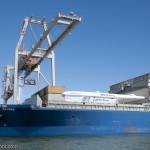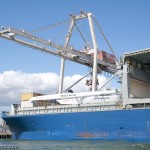For many of you this is the story of the America’s Cup. Stating the obvious; It’s about Television ratings. The rules of sailing have been altered to keep the flow. The races will likely not last more than a few hours at most. It fact the America’s Cup seems to be everything that Peter Wilson (a former America’s Cup sailor himself) was writing against.( see the previous entry)
The Cup is about money, not sport. Is it possible to reconcile the direction the Cup has taken and the direction sailors would like to see the sport take? I don’t see how. These forces are purposefully tugging in opposite directions. What is there to be done? Probably nothing, but to wait and see. The professional arm of sailing, for me is separating itself more and more from the sport as we know it. Is this a bad thing? All other sports have professional arms that operate independently from their respective sport; so why not sailing? Are we simply watching the growing pains of an emerging professional sport? I guess we shall see.
San Francisco needs to tell a new story for an America’s Cup win
San Francisco Business Times – by Patrick Twohy
Date: Friday, March 18, 2011, 1:31pm PDT – Last Modified: Friday, March 18, 2011, 2:20pm PDT
Enlarge Image

Photo: I Wilkins via Artemis Sailing
A Bay Area kid, Paul Cayard, is skipper of the Swedish team challenging for the America’s Cup.

- Patrick Twohy
- Senior Editor
- Email: ptwohy@bizjournals.com
S.F. has won the right to stage the next America’s Cup. So what?
Pulling off the same old white-shoe event custom made for a bunch of smug-looking stuffy old gents and their mega-millions won’t cut it.
Fortunately, no one here wants that. People here, particularly those associated with America’s Cup Event Authority and the city of San Francisco’s side of the deal, know this is a huge chance bring the America’s Cup and San Francisco as a major sailing venue to potentially millions of new fans.
But good intentions alone won’t turn around very traditional ways of doing things in a very old sport.
So how do you tell this story to new readers and viewers?
San Francisco and the America’s Cup Event Authority have to fundamentally reinvent not just the America’s Cup but sailing itself, partly in the minds of participants but mostly in the minds of those they hope to attract, particularly in the United States.
But what kind of story do you tell?
It’s all about the story
Given the massive click numbers on anything we post about the America’s Cup, it’s clear that Business Times readers understand the Cup is fundamentally a business story. That’s a good place to start — the business of America is business and all that.
But how do you get the attention of a broader U.S. public for whom watching golf on TV seems more exciting. (Golf on TV? Really? Isn’t there anything on the Paint Drying channel?)
For the tech-leading Bay Area, the America’s Cup is, among other things, a huge technology story.
It’s about how a remarkable — and remarkably simple — design made a sailboat that goes faster than the wind. Faster than you can safely drive through the S-curve on the Bay Bridge (especially if you’re hoping to catch a glimpse of the racing). Faster even than a U.S. Navy destroyer.
It’s a story about people like Stan Honey, a master navigator and Bay Area sailing icon who, not coincidentally, is also the inventor of the first-down-line technology that anyone who has watched football on TV is familiar with. He has been enlisted to help bring America’s Cup racing to life for the world’s TV viewers.
It’s about personalities
It’s a story about huge personalities (and egos), of course. Dozens of ’em. Start with Oracle Racing boss Larry Ellison. Then move to Paul Cayard, the Bay Area local kid (a graduate of Crestmoor High in San Bruno) who is CEO and skipper of Sweden’s bid to win the Cup.
It’s a story of many things. But there are a few things this story is NOT.
This is NOT primarily a sports story. Yes, the America’s Cup involves struggling against odds, challenging one’s self and one’s team to overcome, bringing your A game; giving 110 percent. Yada, yada. Snore.
Sports pages and websites are already full. If that’s the only place — or even the primary place — you’re looking for attention, well, best of luck to you.
Arrgh, drop the weird sailor talk
And surely, telling this story will have to involve NOT speaking the arcane language that sailors use to describe what they do.
Sailors speak of speeds in knots, directions in starboard and port, wind as pressure, turning as “coming about” — it’s like Steve Martin once said of the French, they have a different word for everything.
In some cases, those terms describe something more accurately than standard vocabulary can, the way “lateral” and “hail Mary” describe different ways of throwing a football. But in many cases, the only purpose sailors-only terminology serves is as a secret sailing handshake to keep the uninitiated out. Avast ye lubbers!
Hey kids, this is your chance at the bigtime. Climb down from your tree fort and join the rest of us. Tell us how fast boats are going in miles per hour. When they turn, it’s right or left, please. Wind is wind — not pressure. Or you’ll lose, no matter who wins the Auld Mug.
There are many ways the Bay Area and sailing could blow this chance to turn sailing into a more mainstream sport. One of the most obvious would be to inadvertently limit this to a story for people like me who already like sailing. And this chance is really much bigger than that.
Read more: San Francisco needs to tell a new story for an America’s Cup win | San Francisco Business Times











